Last night I picked up severeal lines of adult Gannets going west past Europa Point, heading out for the Atlantic. It was a clear signal that migration of these birds had intensified. The passage continues today with small groups flying out in lines. Most are adults which is what you would expect in February. Adults will continue to dominate the passage into April. After that, first, second and third years will become more abundant. The extent of Gannet migration is strongly dependent on age, the youngest birds flying furthest away from the breeding colonies, many staying in the winter areas through the summer. Many of the Gannets were getting attracted to an upwelling off Europa Point this morning, pausing to have a snack before continuing. Here are some photos from today. Notice how some Gannets have fishing lines trailing.
Saturday, February 27, 2010
Thursday, February 25, 2010
St Joseph's Storm
This tranquil image of the Strait of Gibraltar, with the Rock in the foreground and Jbel Musa (Morocco) behind, gives little away in terms of how quickly the weather can turn at any time of the year. Africa and Europe are so close here that one might be forgiven for thinking they were connected. These two geological features were the Pillars of Herakles to the Greeks but it was probably the Phoenicians who first coined the phrase, with reference to their god Melkart.
But the Strait is a nightmare for sailors, and was particularly so for the ancient mariners of 2,500 years ago. Sea mists come in rapidly, with little warning. Here the Jbel Musa just peeps over the horizon and the Strait is lost in the fog.
But, worse still, are the huge waves that build up quickly when the winds blow from the east. The old folk used to tell me that there was always one big one at this time of the year - St. Joseph's Storm. It was so named because it came shortly before or shortly after St Joseph's day, the 19th March.
And they weren't far wrong. Most years there is a big easterly storm around this time. Some have had tragic consequences, as on the 17th March, 1891, when the SS Utopia sank in the Bay and 571 lives were lost. The tragedy is commemorated by this medal.
So imagine how the Phoenicians, in their little boats, must have felt about crossing the narrows! So they stopped in the northern pillar and prayed hard. They did so in Gorham's Cave (we have met this cave in connection with Neanderthals) and left offerings. This pottery mask is one such offering and I can't help feeling that I'm staring at a Phoenician mariner when I look at it.
Among their most prized offerings were scarabs. These were small, thumbnail sized, representations of scarab beetles in paste or glass. On the underside was usually a representation of an animal, person or a god. This one shows a lion jumping on an antelope. How did they get such detail into such a small item, especially as they did not have reading glasses?
Scarab beetles were revered by the Egyptians and, it seems also by the Phoenicians with whom they traded. Once common these great recyclers of the earth are becoming increasingly rare as we sterilise the countryside.
Inside the biological reserve in Doñana seems to be one of they few sanctuaries where sights like these, so common when I was a boy, are now harder and harder to find.
Perfect dung beetle country in Doñana, recalling a scarab scene (below)
Mare and foal represented in a Phoenician scarab from Gorham's Cave (above) and horseman (below)
This scarab (above) shows Horus, the god in falcon form, on the right. Below, a Peregrine rests on the cliffs above Gorham's Cave today
But returning to the St Joseph's Storm, if they come with rain they often cause falls of migrant birds coming from the south. These migrants often include Hoopoes (below):
Hoopoe on spring migration at Europa Point, Gibraltar, very close to Gorham's Cave
This Griffon Vulture never made it despite reaching the European shore. The weather got the better of him.
The big seas were a major worry for the Phoenicians. They were close to nature and used animals to help them navigate and keep close to good weather. Dolphins and Cory's Shearwaters were, like today in the Strait, welcome creatures.
Some things don't change. Here are some dramatic photos of wrecks caused by the treacherous storms in the Strait of Gibraltar, by Europa Point, in recent years:
No wonder the Phoenicians left offerings to placate the gods of the Pillars! And how lucky that the cave preserved them for us to excavate 2,500 years later.
Today's photos are from my archive. The mask and scarabs may be viewed in the Gibraltar Museum.
Wednesday, February 24, 2010
A tale of three species
I was on the upper part of the Rock of Gibraltar today. Barbary Macaques were up to their usual pranks along the crest of the Rock irritating nesting Yellow-legged Gulls
A Peregrine came over to create an unlikely picture of three species each with its own story to tell and brought together by accidents of history. Like so much in ecology, history has had a major role to play in shaping distribution patterns.
Let's start with the Peregrine. A number of pairs breed on the Rock and they have done so for millennia. The Victorian naturalists, notably Howard Irby and Willoughby Verner, saw them on the Rock but they were already recent observations. The Peregrines have been here at least 50 thousand years! The pictures below, from my archive, show fossil Peregrine material that we have excavated from 50-40 thousand year old levels in Gorham's Cave. So the Neanderthals were familiar with the local Peregrines, but were they with the other two players in today's game?
Peregrine tarsometatarsus from Gorham's Cave
Peregrine sacrum from Gorham's Cave
They certainly were not familiar with the sight of Barbary Macaques on the Rock. Despite twenty years of excavation we have never found fossil macaques in our caves. These macaques were certainly in Europe in the Pliocene and for much of the Pleistocene, where they reached north into the United Kingdom, Germany and Austria, but they disappeared mostly by the last-but-one interglacial, Marine Isotope Stage 7, around 200-odd thousand years ago. The ones on the Rock were brought in by the British military as part of the importation of "game from Barbary" in the 18th Century, and they went feral.
They weren't always as numerous as they are today but their habits of coming into people's houses seem to go back some way. Many visitors have described the macaques, among them George Orwell when he visited the Rock in September 1938:
The Barbary Ape is said to be now very rare at Gibraltar & the authorities are trying to exterminate them as they are a nuisance. At a certain season of the year (owing to shortage of food I suppose) they come down from the rock & invade peoples' houses & gardens. They are described as large doglike ape with only a short stump of tail. The same species found on the African coast just opposite.
And what of the gulls? Well, we certainly have gull fossil material from the days of the Peregrine but they may be Herring Gulls. I suspect the Yellow-legged Gull expansion is a recent phenomenon. Irby and Verner certainly don't describe a colony on the Rock in the thousands and I think that the increase, from my own recollection, happened in the late 1970s shortly before the Audouin's Gull boom.
So three species with different stories to tell, came together one spring day of 2010! I wonder what they make of it all?
Trickle of migrants today: Black Kite, Short-toed Eagle, Swallow (lots), House Martin, Hoopoe, Goldfinch, Linnet, Chiffchaff...
Subscribe to:
Posts (Atom)





























































